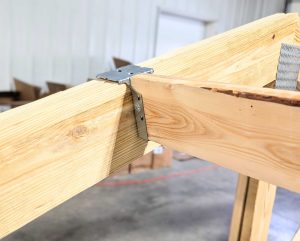Simpson Strong-Tie® has a blog dedicated to Structural Engineering. A recent post written by David Finkenbinder addressed gaps where a member is attached to another by use of a structural hanger.
 Here is an excerpt from the blog:
Here is an excerpt from the blog:
“Have you ever seen this famous sign? You may have seen it while riding the London Underground, to draw attention to the gap between the rail station platform and the train door. The warning phrase is so popular that you may also recognize it from souvenir T-shirts or coffee mugs.
In the connector world, the phrase comes to mind when thinking of the space, or “gap” between the end of the carried member and the face of the carrying member. Industry standards for testing require that a 1/8” gap be present when constructing the test setup (in order to prohibit testing with no gap, where friction between members could contribute significantly), so this is the gap size that is typically permitted for the joist hangers listed in our catalog.
Gaps exceeding 1/8” can affect hanger performance in several ways. A larger gap creates more rotation for the connector to resist by moving the downward force further from the header. Fasteners may also have reduced or no penetration into the carried member due to the gap. Testing confirms that these factors decrease hanger allowable loads for larger gaps.”
In pole buildings where roof purlins are attached to either metal plate connected wood trusses or rafters with hangers, other issues can also result from gaps.
When screws are driven through roof steel and the points end up in a gap – leaks can result. If, as we recommend, all of the purlins have been cut to length in advance, gaps create an overall length “creep” in the roof. This can cause waves in the end truss or rafter (if no end overhangs are present) or fly rafter with an end rafter.
With some prudence, gaps can be avoided.
Make sure both ends of purlins are cut square. While lumber cut at the mill is supposed to be square at each end, there are exceptions. In almost all cases the purlins need to be trimmed to length, so each end can be cut back, if needed.
Even with perfectly square cut purlins, it is essential they are placed in the hangers so each end is tight to the carrying member. It is easiest to fasten the same end of all purlins, then use a come-along to pull the other carrying member tight.
Avoid the Gap – keep everything tight and the overall result will be satisfying both aesthetically and structurally.






